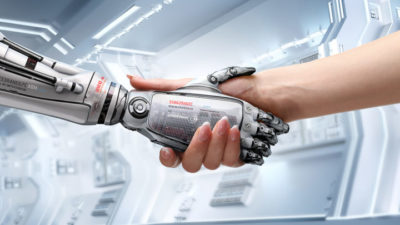
When it comes to contact centres, people generally assume that agents spend their whole day on the phone, calling customers or answering calls. This isn’t actually the case, writes Oded Karev, VP, head of Robotics Process Automation LoB at NICE Ltd.
Today’s agents are expected to fulfil many roles such as admin, sales, customer enquiries and complaint handling. It becomes very challenging for employees to deliver an excellent customer experience while simultaneously handling the admin and processing side of things accurately. As it gets more and more challenging to perform well in all areas within short timeframes, employees become overwhelmed and demotivated. This creates a whole new set of challenges for contact centres’ managers on top of traditional ones such as compliance.
Managers are under pressure to deal with staff churn as a result of unhappy employees leaving the organisation. Recruiting and training new staff becomes logistically challenging and expensive. Adding to this, unhappy employees deliver poor customer experience. This, in turns, leads to an increase in complaint escalations.
While Robotic Process Automation will automate easy and repetitive tasks that don’t require human input and lead to frustration for the agents, and can prove a major component to tackling these challenges, there is no such thing as a one size fits all solution. Let’s have a look at Robotic Process Automation (RPA) and what it can and cannot fix.
How RPA Can Boost Your Business Performance
RPA will improve speed, compliance and accuracy across your business
Let’s start by looking at some RPA success stories. The Results Companies implemented Robotic Automation to achieve complete data accuracy, reduce the processing time, and ensure full regulatory compliance for internal procedures. The processes for employee onboarding and offboarding, which took an hour each time, are now accomplished within seconds as well as 100 per cent data accuracy. Moreover, the robots are not limited by time zone, allowing The Results Companies to continue providing clients with the service they need 24/7.
RPA will help you build the workplace of the future
Legal & General decided to invest in RPA to bring robotic intelligence into its service delivery approach. The inclusion of intelligent virtual attendant robots into the organisation equipped its customer service consultants with the tools to deliver an accurate, efficient and valuable customer experience.
By using RPA, the organisation has generated efficiency gains by accelerating call resolution times. Furthermore, with the assistance of a virtual robotic workforce, customer service consultants can update multiple policies simultaneously. This ensures continual processing accuracy and fast response times to customer questions. Most importantly, advisors now have more capacity to use their interpersonal skills to focus on adding greater value to every customer interaction.
RPA will improve customer experience and drive great back-office process efficiencies
Thomas Cook implemented RPA in its United Kingdom-based operations. Through a combination of attended and unattended automation, the company is improving the customer experience, streamlining its back office, ensuring consistency across markets and saving millions in operational costs.
By replacing all the manual processing of tasks with fully automated processes (executed by robots), Thomas Cook streamlined processes either by completely automating routine tasks or assisting agents to ensure more efficient and engaging customer interactions. These changes have driven millions in savings, introduced global consistency in reporting, reduced the average handle time of in-house processes, increased efficiency, and facilitated a greater focus on customer service. However, despite its benefits, it’s important to remember that RPA is no miracle, one size fits all solution.
RPA isn’t a Magic Formula
Accurate Process Selection is key to Ensuring Automation Deployment
Choosing the correct processes to automate is the first step towards ensuring success.
In fact, one of the biggest pitfalls when it comes to RPA is when the organization selects the wrong process to automate. There are tools available today which ensure accurate process selection. using intelligent automation diagnostic tools.
You will have to make sure you correctly measure how dynamic the environment is as well as how much of the decision-making is made on a case-by-case basis to mention only these two elements. In a general manner, tasks that involve either creative thinking or interaction with other humans are better handled by the human workforce. Also, when looking for a relevant process to automate, remember that robots work differently from humans. So, many steps that a human would need to take within a given operational process may be entirely unnecessary for a robot as it’s digitised and naturally resides within backend systems.
Finally, RPA project success is about achieving business value and ROI. Therefore, there should be a good business case to use automation. Processes that are performed frequently by an adequate volume of users, forming a critical part of the organisation’s success, should be prioritised.
RPA cannot replace your workforce’s emotional intelligence
According to Frost & Sullivan, 71.6 per cent of contact centres feel that up to 25 per cent of the CX tasks done by agents could be automated by 2020. This still leaves a good three quarters that will be handled by the human workforce.
For instance, in a self-service scenario, where a customer would make a request/file a claim online, a backend RPA bot can query and gather customer information and intent and attempt to solve the issue. If the problem isn’t solved, the robot will ultimately pass information and context on to a live agent for handling.
RPA, via its Desktop Automation robots, pre-populate screens of information, remind agents of missing steps or required information, or provide them with next-best-action guidance and information, making it easier for the agent to resolve the case or handle a complex process. Finally, post-call wrap-up can be offloaded to a desktop robot but is often checked or modified by the live agent. So, once you’ve avoided the pitfalls, you know that RPA can do much, but not anything.
RPA isn’t a miracle solution, but it can deliver significant ROI to organisations
When properly planned and understood, RPA can save you time and money. Currently, the average employee spends around 80 per cent of their day on mundane and routine tasks. With RPA, employees are freed from monotonous tasks to undertake more exciting and rewarding activities. For contact centres, this means improved employee satisfaction as employees will feel that their time is better valued.
Research also shows that happiness makes people more productive at work. Companies get happier employees and better results – it’s a win-win situation and something that can’t afford to be overlooked.






